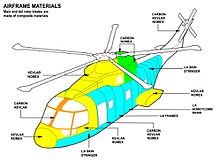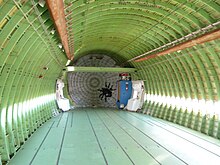Airframe: Difference between revisions
KolbertBot (talk | contribs) m Bot: HTTP→HTTPS |
Rescuing 1 sources and tagging 0 as dead. #IABot (v1.6.2) (Balon Greyjoy) |
||
| Line 37: | Line 37: | ||
=== Postwar === |
=== Postwar === |
||
Postwar commercial airframe design focused on [[airliner]]s, on [[turboprop]] engines, and then on [[Jet engine]]s : turbojets and later turbofans. The generally higher speeds and [[tensile stress]]es of turboprops and jets were major challenges.<ref>{{cite book |author= Charles D. Bright |title= The Jet Makers: the Aerospace Industry from 1945 to 1972 |publisher= Regents Press of Kansas |year=1978 |url= http://www.generalatomic.com/jetmakers/index.html }}</ref> Newly developed [[aluminum]] [[alloy]]s with [[copper]], [[magnesium]] and [[zinc]] were critical to these designs.<ref>{{cite book |work= Key to Metals Database |title= Aircraft and Aerospace Applications |publisher= INI International |year= 2005 |url= http://www.key-to-metals.com/PrintArticle.asp?ID=96 }}</ref> |
Postwar commercial airframe design focused on [[airliner]]s, on [[turboprop]] engines, and then on [[Jet engine]]s : turbojets and later turbofans. The generally higher speeds and [[tensile stress]]es of turboprops and jets were major challenges.<ref>{{cite book |author= Charles D. Bright |title= The Jet Makers: the Aerospace Industry from 1945 to 1972 |publisher= Regents Press of Kansas |year=1978 |url= http://www.generalatomic.com/jetmakers/index.html }}</ref> Newly developed [[aluminum]] [[alloy]]s with [[copper]], [[magnesium]] and [[zinc]] were critical to these designs.<ref>{{cite book |work= Key to Metals Database |title= Aircraft and Aerospace Applications |publisher= INI International |year= 2005 |url= http://www.key-to-metals.com/PrintArticle.asp?ID=96 |deadurl= yes |archiveurl= https://web.archive.org/web/20060308194218/http://www.key-to-metals.com/PrintArticle.asp?ID=96 |archivedate= 2006-03-08 |df= }}</ref> |
||
Flown in 1952 and designed to cruise at Mach 2 where [[skin friction]] required its [[heat]] resistance, the [[Douglas X-3 Stiletto]] was the first [[titanium]] aircraft but it was underpowered and barely [[supersonic]]; the Mach 3.2 [[Lockheed A-12]] and [[Lockheed SR-71|SR-71]] were also mainly titanium, as was the cancelled [[Boeing 2707]] Mach 2.7 [[supersonic transport]].<ref name=AW161121/> |
Flown in 1952 and designed to cruise at Mach 2 where [[skin friction]] required its [[heat]] resistance, the [[Douglas X-3 Stiletto]] was the first [[titanium]] aircraft but it was underpowered and barely [[supersonic]]; the Mach 3.2 [[Lockheed A-12]] and [[Lockheed SR-71|SR-71]] were also mainly titanium, as was the cancelled [[Boeing 2707]] Mach 2.7 [[supersonic transport]].<ref name=AW161121/> |
||
Revision as of 11:22, 22 January 2018

The airframe of an
History

Modern airframe history began in the United States when a 1903 wood biplane made by Orville and Wilbur Wright showed the potential of fixed-wing designs.
In 1912 the Deperdussin Monocoque pioneered the light, strong and streamlined monocoque fuselage formed of thin plywood layers over a circular frame, achieving 210 km/h (130 mph).[2][3]
First World War
Many early developments were spurred by
In 1916 the German Albatros D.III biplane fighters featured semi-monocoque fuselages with load-bearing plywood skin panels glued to longitudinal longerons and bulkheads ; it was replaced by the prevalent stressed skin structural configuration as metal replaced wood.[2]
German engineer Hugo Junkers first flew all-metal airframes in 1915 with the all-metal, cantilever-wing, stressed-skin monoplane Junkers J 1 made of steel.[2] It developed further with lighter weight duralumin in the airframe of the Junkers D.I of 1918, whose techniques were adopted almost unchanged after the war by both American engineer William Bushnell Stout and Soviet aerospace engineer Andrei Tupolev.
Between World wars
The J1 was followed in 1919 by the first all-metal transport aircraft, the
The
The original Junkers corrugated duralumin-covered airframe philosophy culminated in the 1932-origin
In 1937, the Lockheed XC-35 was the first aircraft specifically constructed with cabin pressurization to underwent extensive high-altitude flight tests, paving the way for the first pressurised transport aircraft, the Boeing 307 Stratoliner.[3]
Second World War
During
Due to wartime scarcity of aluminum, the
Postwar
Postwar commercial airframe design focused on
Flown in 1952 and designed to cruise at Mach 2 where
Because heat-resistant titanium is hard to weld and difficult to work with, welded
Modern era

The vertical stabilizer of the
The Cirrus SR20, type certificated in 1998, was the first widely produced general aviation aircraft manufactured with all-composite construction, followed by several other light aircraft in the 2000s.[8]
The
The 2013
Safety
Airframe production has become an exacting process. Manufacturers operate under strict quality control and government regulations. Departures from established standards become objects of major concern.[11]

A landmark in aeronautical design, the world's first
The
The incident bears comparison with the Airbus A300 crash on takeoff of the American Airlines Flight 587 in 2001, after its vertical stabilizer broke away from the fuselage, called attention to operation, maintenance and design issues involving composite materials that are used in many recent airframes.[12][13][14] The A300 had experienced other structural problems but none of this magnitude.
See also
Notes and references
- ^ Michael C. Y. Niu (1988). Airframe Structural Design. Conmilit Press LTD.
- ^ a b c d e f g h i j k l m Graham Warwick (Nov 21, 2016). "Designs That Changed The Way Aircraft Are Built". Aviation Week & Space Technology.
- ^ a b c Richard P. Hallion (July 2008). "Airplanes that Transformed Aviation". Air & space magazine. Smithsonian.
- ^ David A. Weiss (1996). The Saga of the Tin Goose. Cumberland Enterprises.
- ^ Peter M. Bowers (1986). The DC-3: 50 Years of Legendary Flight. Tab Books.
- ^ Charles D. Bright (1978). The Jet Makers: the Aerospace Industry from 1945 to 1972. Regents Press of Kansas.
- ^ Aircraft and Aerospace Applications. INI International. 2005. Archived from the original on 2006-03-08.
{{cite book}}:|work=ignored (help); Unknown parameter|deadurl=ignored (|url-status=suggested) (help) - ^ "Top 100 Airplanes:Platinum Edition". Flying. November 11, 2013. p. 11.
- ^ Leslie Wayne (May 7, 2006). "Boeing Bets the House on Its 787 Dreamliner". New York Times.
- ^ Graham Warwick (Jan 11, 2017). "Airbus To 3-D Print Airframe Structures". Aviation Week & Space Technology.
- ^ Florence Graves and Sara K. Goo (Apr 17, 2006). "Boeing Parts and Rules Bent, Whistle-Blowers Say". Washington Post. Retrieved April 23, 2010.
- ^ Todd Curtis (2002). "Investigation of the Crash of American Airlines Flight 587". AirSafe.com.
- James H. Williams, Jr. (2002). "Flight 587". Massachusetts Institute of Technology.
- ^ Sara Kehaulani Goo (Oct 27, 2004). "NTSB Cites Pilot Error in 2001 N.Y. Crash". Washington Post. Retrieved April 23, 2010.
